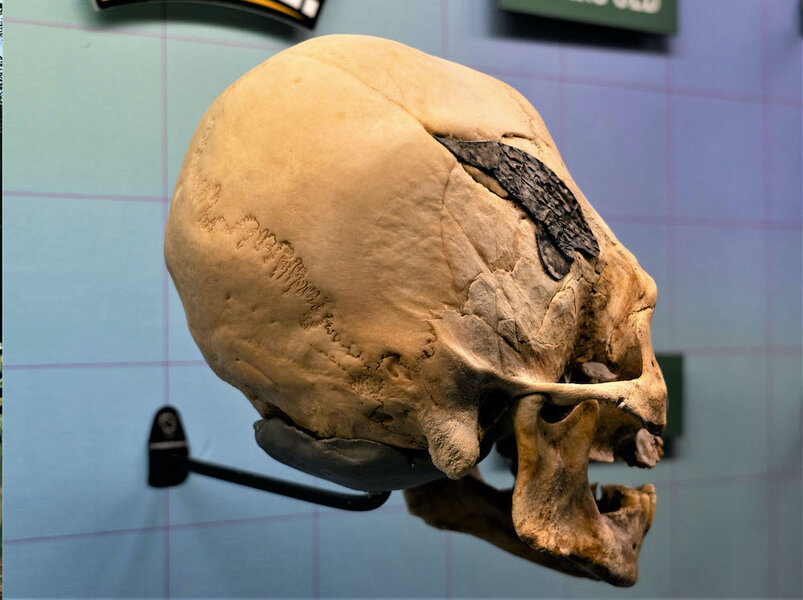Create a free profile to get unlimited access to exclusive videos, sweepstakes, and more!
Is the space-age metal implant in this ancient skull for real?
It's definitely human, but...

If an alien civilization far more advanced than anything on Earth existed thousands of years ago, would they have embedded a piece of metal inside someone’s skull? That is, at least, what this looks like.
An (undoubtedly human) skull from Peru, which was donated to the Museum of Osteology in Oklahoma from a private collection, is now the object of controversy because of a mysterious metal implant. The elongated skull almost looks alien, but head-binding was a common practice in Peru and other parts of the ancient world. It has not yet been carbon dated or examined up close by any archaeologists. Whether the implant is authentic raises questions.
But why is there even a gaping hole in the first place? It could the been blunt-force trauma. It could have also been trepanation. Long before ibuprofen existed, it was thought cutting an opening into the skull would relieve pressure from fluid that caused headaches. Archaeologist John Verano of Tulane University, an expert in trepanned skulls and also author of the book Holes in the Head, is not convinced the piece of metal had any medical use back then.
“Forgeries have been pretty easy to recognize because they made no sense in terms of surgical treatments,” he told SYFY WIRE. "I'm highly dubious; it is probably a cranium ‘accessorized’ to increase its value to a collector.”
Verano had previously seen skulls that could have been forgeries in a Peruvian museum. That particular museum also has a reputation for fakes. In one of these skulls that he observed, the trepanation was real based on the linear way the opening was cut, but it was then filled with gold. Remember that scene from Game of Thrones where Khal Drogo poured molten gold onto the head of a screaming Viserys? It looked as if the gold had been molten at the time the hole was plugged — and had this person been alive, it would have probably felt like Viserys’ demise.
Trepanation sounds gruesome, but before there was so much as a semblance of modern medicine, it was the only headache relief that many ancient peoples could think of. If the extra fluid could ooze out, then the pressure would be relieved, but what was problematic about this was that you would still be left with a literal hole in your head. The procedure ended up being fatal for some. Others who underwent it survived, as evidenced by signs of healing in ancient trepanned skulls, but they were especially vulnerable to infection without antibiotics.
“The skull does show multiple fracture lines that mark a serious blow to the head, although he survived the injury, as marked by healing of the margins of the fracture,” Verano said. "Unfortunately, if there is a trepanation under the metal it is not visible, so it's unclear if there is in fact evidence of surgery.”
Your brain is just about the last place you would want an infection. It is impossible to tell whether survivors of trepanation died from that or something else, but there was a high risk. It is possible that the owner of this skull had not undergone a trepanation at all and instead was the victim of severe head trauma. What they succumbed to is and may remain a mystery. It might have been meant for the afterlife, though that is unlikely. Verano knows of only one trepanned skull whose hole was covered with metal that was apparently a grave offering.
In Holes in the Head, Verano describes a Paracas mummy from Peru’s southern coast. There had been a trepanation performed on the forehead, and the wound was covered with a thin plate of hammered gold, but the plate itself was clearly not made to be an implant. Though many archaeologists thought it was evidence that ancient Peruvians used some sort of implant to keep the skull protected, the problem is that the patient did not survive the trepanation. Meaning, if this had been cranioplasty — something it didn’t appear like — then it failed.
"X-rays probably won't help, because they won't penetrate the metal and show what's under it,” said Verano. "If the metal could be somehow delicately removed it would be helpful, but this might damage the skull. An elemental analysis of the metal could be informative.”
He added that he had never seen metalwork like this from ancient Peru. So is it a previously unknown innovation? Blatant forgery? Aliens? The answer is still buried in the past.




























